Transport • Air traffic takes off again, leaving the climate transition on the tarmac
Air traffic is on track to return to 2019 levels and exceed them in 2023. However, the current energy crisis underlines the unsustainability of a fuel based on fossil energy. The chosen strategy appears to be the decarbonization of fuel and aviation activities, rather than modal shifts in transport demand.

Following an unprecedented paralysis of the aviation sector caused by the pandemic, airlines and airports are almost back to their “normal”. Despite some regional and inter-sectoral differences, air traffic is on track to return to 2019 levels and exceed them in 2023. While the sector prepares for exponential growth in demand, the current energy crisis underlines the unsustainability of a fuel based on fossil energy. To reconcile geopolitical and ecological priorities, the chosen strategy appears to be the decarbonization of fuel and aviation activities, rather than modal shifts in transport demand.
- Despite turbulence, air traffic successfully takes off again
- Traffic picks up fast while attempts to reduce carbon intensity lag behind : CORSIA kick-off delayed, carbon offsetting on the back burner
- Traffic picks up fast while attempts to reduce carbon intensity lag behind CORSIA (Carbon Offsetting Scheme for International Aviation) kick-off delayed, carbon offsetting on the back burner
- Calls to reduce traffic receive relatively less attention
After going through a very turbulent zone in 2020 and 2021, air traffic has taken off again. But initiatives to direct the sector towards decarbonization are lagging behind the recovery of traffic growth, which is already catching up to pre-pandemic levels. Alternative to fossil fuels, either based on biofuels or electricity, are unlikely to be sufficiently developed before 2040, although some successful tests were observed in 2021 and 2022. While awaiting 2040, the effectiveness of the CORSIA system, designed to offset the sector’s emissions, has been weakened and delayed by the drop in traffic in 2020. As a result of these realities, the ultimate option – a decrease in traffic – is increasingly being called for, especially in Europe, although it goes against the economic raison d’être of airlines. Recent studies and civil society therefore insist on the role of states, local governments, and airports to reach national emissions reduction targets.



